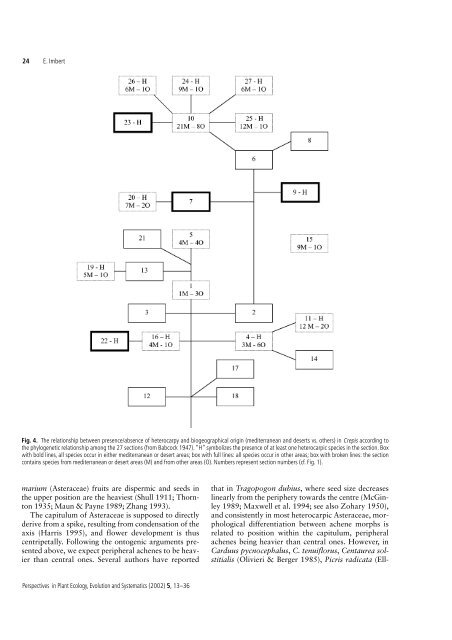Ecological consequences and ontogeny of seed ... - Accueil du site
Ecological consequences and ontogeny of seed ... - Accueil du site
Ecological consequences and ontogeny of seed ... - Accueil du site
You also want an ePaper? Increase the reach of your titles
YUMPU automatically turns print PDFs into web optimized ePapers that Google loves.
24 E. Imbert<br />
Fig. 4. The relationship between presence/absence <strong>of</strong> heterocarpy <strong>and</strong> biogeographical origin (mediterranean <strong>and</strong> deserts vs. others) in Crepis according to<br />
the phylogenetic relationship among the 27 sections (from Babcock 1947). “H” symbolizes the presence <strong>of</strong> at least one heterocarpic species in the section. Box<br />
with bold lines, all species occur in either mediterranean or desert areas; box with full lines: all species occur in other areas; box with broken lines: the section<br />
contains species from mediterranean or desert areas (M) <strong>and</strong> from other areas (O). Numbers represent section numbers (cf. Fig. 1).<br />
marium (Asteraceae) fruits are dispermic <strong>and</strong> <strong>seed</strong>s in<br />
the upper position are the heaviest (Shull 1911; Thornton<br />
1935; Maun & Payne 1989; Zhang 1993).<br />
The capitulum <strong>of</strong> Asteraceae is supposed to directly<br />
derive from a spike, resulting from condensation <strong>of</strong> the<br />
axis (Harris 1995), <strong>and</strong> flower development is thus<br />
centripetally. Following the ontogenic arguments presented<br />
above, we expect peripheral achenes to be heavier<br />
than central ones. Several authors have reported<br />
Perspectives in Plant Ecology, Evolution <strong>and</strong> Systematics (2002) 5, 13–36<br />
that in Tragopogon <strong>du</strong>bius, where <strong>seed</strong> size decreases<br />
linearly from the periphery towards the centre (McGinley<br />
1989; Maxwell et al. 1994; see also Zohary 1950),<br />
<strong>and</strong> consistently in most heterocarpic Asteraceae, morphological<br />
differentiation between achene morphs is<br />
related to position within the capitulum, peripheral<br />
achenes being heavier than central ones. However, in<br />
Car<strong>du</strong>us pycnocephalus, C. tenuiflorus, Centaurea solstitialis<br />
(Olivieri & Berger 1985), Picris radicata (Ell-


